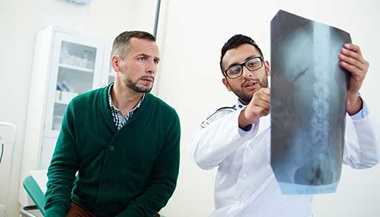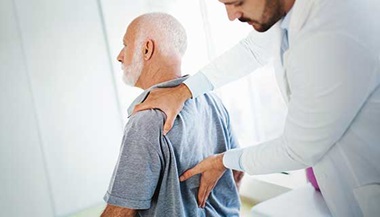(uplifting piano music) >> We were actually looking for a house down the road.
And we drove by here, and I made this dumb mistake of stopping and getting a pamphlet.
And we made the offer on the house, and it was accepted.
And um, moved in and I said, "Well if we're gonna be here," very active, "we need to be doing stuff." And, so I thought I was going to just work on the farm.
We were going to get cattle, and um, shortly after we moved in, I started having back issues.
And that's where everything started.
All right, Bill, we gotta pick up some rocks, okay?
Come on down.
>> Ed: I couldn't get out of my truck, and I had to have somebody come in, go over plans him and tell him what I needed him to do, and that was very frustrating.
>> He would hold on to his >> Belt loops.
>> Yeah, like this.
So that the front of him wouldn't move.
>> A back doctor did take a look at me, and he sent me to a pain management doctor.
He looked at everything and he said, "You need a bone density test." I had the test done, and I was in the changing room.
I went down to tie my shoe and I cracked a rib.
>> When I saw Ed first time in the clinic, uh, he was in severe pain.
And we scanned him, did an MRI and a CT of his spine, and we found that he had at least 6 to 7 compression fractures of his spine.
So that's when we decided that we will take care of Ed by doing what's called the vertebral implant or some people just call it a vertebral stent.
>> By looking at the MRIs and X-rays, and CAT scans, he diagnosed that I had at least 9 vertebrae that needed to be corrected.
I explained how they were little jacks that they used to um, separate the vertebrae.
And they would put a bone cement in between em, to support them.
>> This is the stent and, this is this is completely deployed right now.
So the endplate of the vertebras would be right here.
And if I would be happy with this position, then we will be starting to put cement in, and there are two side holes in the central bar.
And that's where the cement comes out and fills up the central portion of the implant, and anchors the implant within the vertebra.
Ed had about 6 or 7 fractures, and we do 3 levels in one sitting.
So, I picked his worst 3 levels which were giving him the most pain, and we treated those 3 levels, and we put uh, implants in 2 of them.
Which was where the fulcrum of his curve was, so that we could, we could actually restore some height so that it could straighten up his spine a little bit.
Only few places offer this uh, treatment all over the country and Hopkins is one of the premier sites for this.
>> Do you want more?
>> (babbles) >> Yes or no?
>> I saw him the second or third day after I had done the procedure.
I was so glad to see him walking straight with his back up, without somebody holding him.
It's amazing when you see that your patients feel so much better within a few days of the procedure.
That's what we strive for, and that's what we really want.
That makes your day, that makes your week, that makes your month.
>> If you think about it, in the middle of May we had a hospital bed in our family room.
We had a walker.
We had a cane.
You were hardly getting around, and you've been so fine since your third surgery that you can do all the stuff that you were doing before.
>> Mhm.
Now I'm at the point now, where, you know, I feel confident with the grandkids.
The kids pick up rocks and right, and it's all because of the back surgery, and uh, now I can make them have a little bit of a work ethic, which is something that I really try to instill into our kids.
You lose your independence, and you start getting your independence back.
It's a great feeling.
Johns Hopkins is one of the nation’s premier sites for the spinal implant procedure. Ed Dubois struggled with multiple spinal fractures and severe pain until he was connected with Dr. Majid Khan, Interventional Neuroradiologist who performed a spinal (vertebral) implant procedure for height restoration and to help straighten Ed's spine. Choosing #JohnsHopkins, has significantly improved Ed's quality of life.





